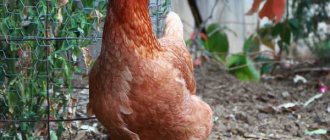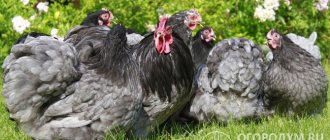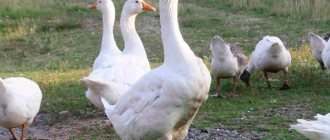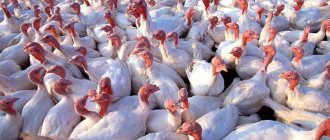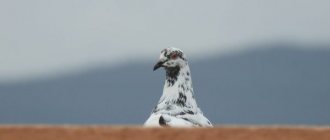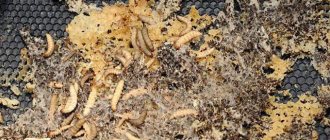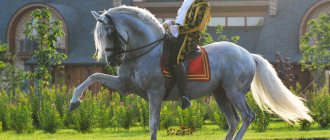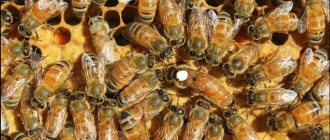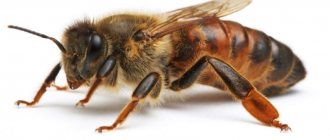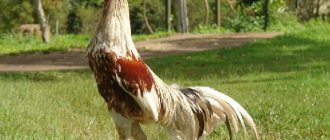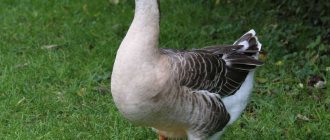Today we will introduce readers to an interesting breed of chickens - Naked Neck. With a very unique appearance, the bird has good egg and meat productivity, which makes it very attractive to owners of small farms and private farmsteads.
Representatives of the breed have an unusual appearance; they can be easily distinguished at first glance from other chickens by the absence of feathers on the neck
You can get an idea of the main features of “naked necks” from the table:
| Parameter | Characteristic |
| Class | Birds |
| View | Chickens (Gallus gallus L.) |
| Breed | "Naked" |
| Productivity type | Meat and egg |
| Plumage color | White, black, blue, gray, motley, red, partridge |
| Age of puberty | 6 months |
| Egg production indicators | Medium (up to 180 units per year) |
| Egg weight | About 60 g |
| Shell color | Cream or beige |
| Hatchability and survival of young animals | Good (94-95%) |
| Growth rate of young animals | High |
| Live weight of an adult | Chicken – 2.5 kg, rooster – up to 3.5 kg |
| Consumer qualities of meat and eggs | Very high |
| Sustainability | The bird is unpretentious to living conditions, easily tolerates unfavorable temperatures (including frosts down to −15 degrees), and almost never gets sick. |
| Year of registration in the State Register of the Russian Federation | 1993 |
| Originators | Federal State Budgetary Institution "Federal Scientific Center for Animal Husbandry-VIZh named after Academician L. K. Ernst" (Moscow region), Federal State Budgetary Institution Federal Scientific Center "All-Russian Scientific Research and Technological Institute of Poultry Breeding of the Russian Academy of Sciences", LLC "Gene Fund" (Sergiev Posad, Moscow region) |
Description of the naked breed of chickens
It is not easy to find a purebred naked-necked bird, and its cost is relatively high, so barenecks are not yet competitive with other meat and egg breeds.
Origin of the breed
Presumably the birthplace of the unusual bird is Spain. Bare-necked chickens came to Russia from Hungary and Romania 100 years ago. That’s why in the country chickens are called Transylvanian, although in other places they are usually called Spanish.
In Russia, the bird is common among the population in the southern regions
There is a version that the appearance of the bare-necked bird is due to the displacement of Indian fighting chickens with other breeds. It is also possible that nakedness is a genetic mutation that can be transmitted hereditarily. After its appearance, the owners of the bird, allowing special individuals into breeding, formed the breed.
Holo-necks are most common in Austria and Moldova.
Appearance
The birds are somewhat similar to turkeys. Those who see barenecks for the first time often mistake chickens for patients due to the lack of feathers on the neck and crop, with the lush plumage of the rest of the body. In reality, chickens do not have follicles on their bare skin.
The main distinguishing feature of the breed is the bare neck.
Chicks hatch with bare necks. An adult bird has exposed, rough, bright red skin with pronounced wrinkles. A small spot with feathers forms on the head behind the crest, like a cap.
On the front of the neck, near the crop, there is an island of feathers - a collar. There is no feather at the necks on the inside of the thighs and under the wings, which is convenient when plucking the carcass. The color of the bird is varied, including red and motley.
Be sure to read:
Rhodonite chicken breed: description, photo, features of the breed
Goloshka
The body of chickens is powerful and squat. The muscles are well developed. The wings are lowered down, loosely fitting to the sides. The head is compact, wide, with yellow-red eyes and a leaf-shaped crest - medium in females and large in males.
The bare-necked gene is classified as dominant. When birds are crossed with other breeds, chickens appear with bare necks.
Temperament
The chickens are calm, do not get into fights in the poultry house and do not show aggression towards humans.
However, barenecks are quite timid and anxious; they should be housed in a place protected from extraneous, sharp sounds. If a hen is stressed, she may reduce her egg production.
Bare-necked breed of chickens
Bare-necked roosters have a violent temperament. They do not tolerate other males on their territory - and not only roosters, but also drakes and geese. At a moment of particular excitement, they can attack the owner, which can be quite dangerous.
Reviews
Bare-necked chickens are raised quite productively and often, so there are plenty of reviews about the breed.
They all boil down to the following advantages:
- Good survival rate of young animals - 95% is considered the norm.
- Excellent taste of meat and easier plucking process due to the absence of feathers on some parts of the body.
- Early egg laying, and hens continue to lay eggs even in December and January.
- Good productivity of laying hens - but this point is controversial for many, since the priorities of each bird owner are different.
- Pickiness and endurance, even at sub-zero temperatures.
- Good presentation of eggs.
There is basically only one minus, and it is quite subjective - the unsightly appearance of the birds.
Productive and exterior characteristics
Chickens are versatile. A laying hen produces from 160 to 180 eggs with brown shells weighing 60 g per year. Birds begin to lay eggs at 5.5 months. The description of egg production is close to that of most universal breeds.
Adult roosters gain up to 3.5 kg, and chickens - up to 2.5 kg. Some males can grow up to 4.5 kg, but this weight usually adds to their fat, which is deposited in the bird due to poor nutrition and lack of physical activity. There is a lot of white meat on the carcass due to the high development of the pectoral muscles.
There is a lot of white meat on the carcass due to the high development of the pectoral muscles
According to the exterior, chickens should not have feathers on the neck, under the wings and on the inside of the thighs. The presence of feathers in these areas is a reason for culling. Also, a bird should not be allowed for breeding if it has dark eyes, white lobes and a crown-shaped comb.
External differences between a broiler and a regular chicken
Hybrids have a number of visual and physiological differences from their egg relatives. We will consider them further.
Color
Broiler chicken is completely white, but at a younger age it is completely yellow. During plumage development, white feathers appear first at the tips of the wings. If the chicken has colored pigment spots on its body - black, red or brown, especially on the head, the scallop is most likely a representative of the egg breeds, which include the Black Moravian, Russian White and Minorca.
Meanwhile, it is impossible to accurately determine whether a chicken is a broiler type just by color, since chicks of other breeds can also be completely yellow, and as they develop, they become completely white. In this regard, it is necessary to continue further examination of the individual in order to accurately establish its species.
Body structure
By this characteristic, a broiler can be distinguished from the age of 5-7 days from birth:
- The body shape of broilers is wide and rectangular, while that of laying hens is more oval and smooth;
- broilers have a wide chest and well-developed muscles, which are especially visible on the thighs of older chickens;
- The paws of broilers are shorter than those of other breeds, but they are thicker and more stable, since they must easily withstand considerable weight;
- broiler wings are shorter than those of their relatives;
- The head of a week-old broiler looks awkwardly large relative to the proportions of the body, but over time it will become normal in shape, so the bird’s shape will become proportional.
Sexual characteristics
In broiler chickens, sexual differences have been poorly visible for quite a long time, which is due to two factors:
- cockerels and hens have poorly developed combs and beards;
- Birds do not have beautiful decorative earrings.
The fact is that hybrids are not intended for further reproduction, therefore, during selection, sexual differences were taken into account little. In chickens of egg breeds, it is much easier to establish sexual differences, since their combs and beards are well developed.
Weight
Broilers are focused on rapid weight gain, so they weigh more than laying hens, and starting from the first days of life:
- The weight of a day-old broiler is 45-50 g, and a chicken of egg breeds is 30-35 g. Some laying hens may weigh more than the standard. Most likely, they will grow up to be quite large individuals.
- On the 5th day of life, boilers significantly gain weight - their weight can exceed 100-115 g. At the same time, ordinary chickens are already significantly behind them in weight - their average weight is up to 75 g.
- On the 10th day, the weight of a broiler approaches 180-200 g, and that of a regular chick approaches 110 g.
- A month-old broiler weighs about 1 kg, and a regular individual weighs about 280 g.
You can clearly see how a broiler chicken differs from a simple chick in the following video:
Features of keeping bare necks
There are no difficulties in keeping birds. No special conditions are required. When the temperature in the poultry house ranges from +12 to +16 degrees Celsius, the chickens do not stop laying eggs even in winter and willingly go out for a walk even in severe frost. The breed is naturally highly frost-resistant. If the chicken coop is colder than -5 degrees, egg production will stop completely until spring.
Be sure to read:
Bielefelder chicken breed: productivity, description, pros and cons of keeping a home
Diseases
The innate immunity of this bird is good, but with gross violations of nutrition and hygiene in the poultry house, a decrease is observed, and the Golosheks can become ill with any of the known diseases.
The weak point of this bird is considered to be its legs, which are sensitive to hypothermia and prone to inflammation. The farmer needs to check their condition among the livestock.
- Parasites
- Infectious
- Other
Chicken mite
How to treat a chicken coop and how to treat a bird. Description of drugs and methods of control
Read
Coccidiosis
Thirst, loss of appetite, swelling, bloody droppings, anemia, weakness, poor coordination
Read
Ascariasis
Loss of appetite, liquid droppings, pale mucous membranes of the comb, limbs, ruffled plumage, lethargy, vomiting
Read
Amidostomiasis
Symptoms of the acute form: apathy, general weakness, decreased or lack of appetite, breathing problems, unsteady gait, retarded growth and development
Read
Prostagonymosis
Decreased mobility, loss of appetite, unsteady gait, bloating, fever, impaired egg laying, exhaustion
Read
Knemidocoptic mange (“lime foot”)
Acute symptoms: light gray bumps appear on the legs, the bird limps and stands on one leg, the cloaca and joints become inflamed, the beak is deformed
Read
Heteracidosis
Symptoms: indigestion, diarrhea, loss of appetite, lethargy, decreased egg production, retarded growth and development
Read
Trichomoniasis
Symptoms of the acute form: fever, depression and loss of appetite, diarrhea with gas bubbles and a putrid odor, enlarged goiter, difficulty breathing and swallowing
Read
Pullorosis (typhoid fever, salmonellosis)
Weakness, lack of coordination, drooping eyelids, difficulty breathing, lack of appetite, indigestion
Read
Colibacillosis
Lack of appetite, thirst, sudden increase in temperature, pale scallops, diarrhea
Read
Pasteurellosis
Fever, foamy mucus, change in stool color, refusal to feed, thirst, lethargy, wheezing, heavy breathing
Read
Marek's disease
Paralysis of the limbs, difficulty breathing, severe exhaustion and loss of strength, refusal of food and water, pallor of the scallop
Read
Gumboro disease
Diarrhea, loss of appetite, trembling legs and head, sudden death
Read
Laryngotracheitis
Weakness, swelling of the neck, difficulty breathing, cough, wheezing, blood clots in the mucus released when coughing, lack of appetite, indigestion
Read
Bird flu
Refusal to eat, anorexia, diarrhea, purulent discharge, hoarse breathing, greenish-brown droppings, seizures, darkening of the ridge
Read
Newcastle disease
Decreased appetite, fever, respiratory distress, immobility, conjunctivitis, bloody diarrhea
Read
Apteriosis
Complete or partial absence of plumage, loss of tail feathers, broken embryonic fuzz in young animals, delayed growth of plumage, pecking
Read
Pterophagy
Plucking and eating feathers. What is the reason, why does it require urgent intervention and how to prevent the disease?
Read
Yolk peritonitis
Symptoms of the acute form: loss of appetite, gray-green color of feces, sudden drop in egg production, calcareous deposits on the shell, bluish tint and baldness of the abdominal skin
Read
Cloacite
Symptoms: depressed state, decreased appetite, weight loss, increased need for water, loss of plumage, inflammation and bulging of the cloaca, the presence of ulcers on the mucous membrane, decreased egg production
Read
Bird breeding
Goloshka
Poultry is not bred in poultry farms. You can meet the breed on personal farmsteads and in small farms raising chickens for sale.
To obtain a fully fertilized egg, 1 rooster per 10 hens is required. The bird's brooding instinct is almost completely lost, and an incubator is used to produce chicks. The incubation mode is standard, as for other breeds of chickens. The chicks hatch at 21 days.
Eggs begin to feed 2-3 days before hatching.
Feeding
It is recommended to feed chickens with wet mash or boiled vegetables in the morning, and grain in the evening. Clean water is a must.
The chickens are fed boiled eggs, grated, and gradually cottage cheese and dietary supplements are added to them, and over time they switch to grains.
- Stern
- Recipes
- Supplements
Compound feed pk-1
Description of food for egg breeds. Instructions for feeding laying hens
Read
Compound feed pk-2 and pk-3
Mineral and vitamin compositions, feeding standards
Read
Compound feed pk-4
Used to feed laying hens aged 15-17 weeks
Read
Compound feed pk-5
Composition and instructions for feeding broiler chickens
Read
Purina® Pro
Important differences from the previous line, application patterns Start, Growth, Finish
Read
Barley and wheat for laying hens
Germination and steaming of barley and wheat for chickens: how to do it correctly and how to give it to laying hens
Read
Wheat for broilers
Rules for feeding broiler chickens with wheat. Dosage for chickens from the second day of life and adult birds
Read
Mash
Making mash for broilers at home
Read
Rice and buckwheat
How and in what form you can use rice and buckwheat to feed chickens. Standards for adult birds and chickens
Read
Bread
What kind of bread can you feed chickens and how to do it correctly
Read
Fish
The product is given in limited quantities: overfeeding can cause serious harm to the bird
Read
Chalk
Chalk as a food additive for chicken feed. Feeding standards for chickens, young animals and laying hens
Read
Meat and bone meal
Meat and bone meal is a mandatory additive for feeding chickens, containing protein and fats of animal origin.
Read
Fish fat
How to give fish oil to chickens, layers and broilers. What are the benefits of the drug and are there any contraindications?
Read
Limestone
Limestone (dolomite) flour in the diet of chickens. Advantage over chalk and feed shell
Read
Salt
Daily dosage of salt for adult birds and young animals and cases of unwanted use
Read
Feeding barenecks
Goloshka
No special diet is required for poultry. The bird's diet should include grains, grass, root vegetables (boiled and chopped), zucchini, pumpkins and wet mash with whey or milk. To provide the chicken with minerals, it is necessary to add bone meal to the feed.
They provide food in the morning and evening in the summer, and also during the day in winter. Feeders are washed and disinfected once a week. Water in the drinking bowl is needed constantly. Change it once a day, after washing the drinking bowl.
Chicken diet
There are no special requirements for the diet of Golosheykas. However, the more balanced the diet, the faster the chickens will gain weight, the stronger their immunity will be and the higher their egg production rates. Poultry farmers recommend including in the diet:
- Fresh grass.
- Vegetables. They can be given either fresh or added to mash.
- Cereals. They should form the basis of the diet. Cereals are given both whole and ground. It is also recommended to give the bird sprouted grain, as its consumption stimulates an improvement in egg production.
- Sources of calcium. The most common sources of calcium are: chalk, crushed shell rock, crushed eggshells. The ideal option is crushed shell rock. Eggshells are dangerous because a chicken can recognize them as eggs. If this happens, there is a high probability that the chickens will begin to peck at their own eggs to obtain calcium. As for chalk, it is often prohibited to give it to birds, as it can stick together in the stomach, thereby causing blockage of the gastrointestinal tract.
- Mash. It is advisable to give them at lunch. The mash is distinguished by the fact that it contains a large amount of useful substances. You can add cereals, vegetables, bone meal, salt, etc. to the mash. In addition, they can be cooked in meat broth.
- Yeast. They are necessary when you need to accelerate weight gain.
Chickens are fed three or four times a day. In the summer, it is advisable to give the chickens dry food, and in the winter, the emphasis is on mash.
Chicken keeping
In order for chicks to grow into healthy chickens, they need to be provided with the right conditions in the first two months of life. Chicks should be kept in a heated brooder, clean and dry. In the first week of life, chickens are kept at a temperature of +30 degrees, the second - at +28 degrees, and then gradually reduce the indicators to +18 degrees by the month. The cage must be cleaned daily.
Chicken naked chicken
Feed, which can spoil, is given to chickens in the first 10 days once every 2 hours. The chicks always have crushed grain or dry starter feed. Water or milk stands there all the time. The diet for chickens is standard, as for other breeds.
Keeping adult chickens
An adult bird is kept in a poultry house with a free range. The chicken coop requires lighting and ventilation. Drafts and humidity are unacceptable. Bedding in the chicken coop is required. It is best to make it from peat and loosen it several times a week. It is permissible to cover the floor with sawdust or straw.
Be sure to read:
Chickens of the Wyandotte breed - decorative appearance and excellent productivity
Chickens must be provided with roosts and nests inside the chicken coop. The length of the perch is calculated based on the fact that 1 bird should have at least 30 cm of perch length. Nests are made from round baskets or wooden boxes. The hen must fit completely inside them.
The diet for chickens is standard, as for other breeds
Complete cleaning of the poultry house is carried out in the spring. At this time, all the litter is replaced and the poultry house is whitewashed with quicklime for disinfection. Then the litter is only loosened and added if it is trampled down.
Growing
Planting density – 3-4 adult birds per 1 sq.m. According to the description of the breed, bare-necked chickens are hardy, but they cannot be kept in the cold. The chicken coop must be well insulated. A layer of dry bedding is laid on the floor, which is regularly updated and turned. In winter, the thickness of the layer is increased.
The optimal temperature for preserving egg laying in the winter season is +12 degrees. When reduced to +1...5 degrees, productivity drops by about 20%. In cold winters, heating is required - it is convenient to use infrared lamps. The humidity in the chicken coop should not rise above 60-70%. Supply and exhaust ventilation is installed to remove exhaust air and ammonia fumes.
In autumn and winter, the duration of daylight hours is maintained at 12-14 hours. Lamps are hung at a height of 1.5-2 m. To provide natural light, the window area must be at least 1/10 of the floor area.
Perches are placed 40 cm above the floor. The cross-section of the bar is 4x5 cm. Drinkers and feeders are installed in the room. The feeding and watering front is 10 and 2 cm, respectively. Provide separate containers with ash and sand (wall height - 16-20 cm), containers with fine gravel, and shells. For every 5-6 laying hens, prepare 1 nest. The boxes are made of plywood or plank and installed 60 cm above the floor in a secluded place (ladders are provided for lifting).
The walking area is fenced with a net. Height - 2 m. In winter, birds are allowed to walk in good weather and in moderate frosts (up to -10 degrees). The area is covered with bedding material to prevent hypothermia.
Advantages and disadvantages of the breed
Among the disadvantages of the bird, it is worth noting its strange appearance.
Advantages of the breed:
- versatility;
- high meat and egg productivity;
- good immunity;
- simplicity in content.
Among the disadvantages of the bird, it is worth noting the strange appearance and aggressiveness of some roosters. The difficulty in purchasing purebreds is sometimes considered a relative disadvantage.
Diseases
Spanish bare-necked chickens are famous for their good immunity to various diseases.
But they also have weak points, the main one is their paws, therefore:
- It is necessary to carefully and regularly inspect the birds and note possible defects - crooked fingers, swollen joints, the formation of a whitish coating or lameness.
- Treatment can be based on the characteristics of the disease, but most often unhealthy birds are sent for slaughter.
- It’s easier to carry out preventive measures. These include:
- destruction of parasites through regular disinfection of the premises;
- eliminating sharp objects that can cause injury to limbs.
- Also, chickens are given ash baths.
Naked-necked chickens are very convenient and profitable for households and breeding for meat on a small scale for commercial purposes. They are comfortable and unpretentious, lay eggs well even in the cold season, practically do not get sick and have an interesting appearance.
